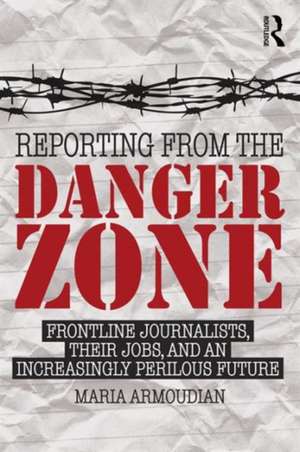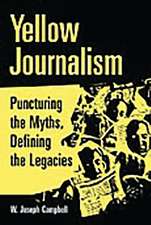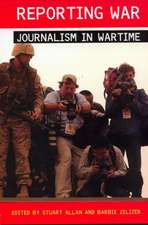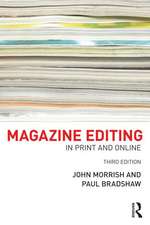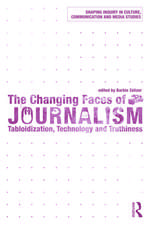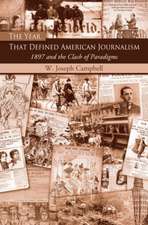Reporting from the Danger Zone: Frontline Journalists, Their Jobs, and an Increasingly Perilous Future
Autor Maria Armoudianen Limba Engleză Paperback – 9 aug 2016
| Toate formatele și edițiile | Preț | Express |
|---|---|---|
| Paperback (1) | 379.75 lei 6-8 săpt. | |
| Taylor & Francis – 9 aug 2016 | 379.75 lei 6-8 săpt. | |
| Hardback (1) | 1106.02 lei 6-8 săpt. | |
| Taylor & Francis – 10 aug 2016 | 1106.02 lei 6-8 săpt. |
Preț: 379.75 lei
Nou
Puncte Express: 570
Preț estimativ în valută:
72.66€ • 75.87$ • 60.14£
72.66€ • 75.87$ • 60.14£
Carte tipărită la comandă
Livrare economică 04-18 aprilie
Preluare comenzi: 021 569.72.76
Specificații
ISBN-13: 9781138840058
ISBN-10: 113884005X
Pagini: 164
Ilustrații: 10
Dimensiuni: 152 x 229 x 15 mm
Greutate: 0.23 kg
Ediția:1
Editura: Taylor & Francis
Colecția Routledge
Locul publicării:Oxford, United Kingdom
ISBN-10: 113884005X
Pagini: 164
Ilustrații: 10
Dimensiuni: 152 x 229 x 15 mm
Greutate: 0.23 kg
Ediția:1
Editura: Taylor & Francis
Colecția Routledge
Locul publicării:Oxford, United Kingdom
Public țintă
Postgraduate, Professional, and UndergraduateCuprins
1. Ethical Journalism and Why it Matters 2. War Correspondents at Home 3. War Correspondents Abroad 4. The Danger Zones of Yesterday 5. 21st Century Danger Zones, More Dangerous than Ever 6. 21st Century Journalism in the Danger Zone 7. War Stories and their Effects 8. Conclusion: Witness to the World at War
Recenzii
"This well-written, innovative and nuanced book dissects the vital but increasingly perilous roles played by journalists in danger zones. Through compelling narratives of horrifying violence witnessed, evaded or experienced, and analyses of how these conditions jeopardize professional and independent journalistic observation, Armoudian illuminates the difficulties in disseminating news despite omnipresent communication technology. Framed by deep scholarship, enlivened by sensitive interviews with journalists who have seen too much, this book merits urgent and wide attention from scholars, practitioners and those interested in understanding threats to human rights and democracy throughout the world." –Robert M. Entman, George Washington University
"During a time when foreign correspondents’ work is often taken for granted, or even disparaged, Maria Armoudian sets the record straight. She describes the difficulties and dangers of gathering news in the world’s trouble spots, and her message deserves rapt attention from news consumers and students of journalism." –Philip Seib, University of Southern California
"Armoudian's richly detailed accounts of reporting from conflict zones explain what motivates journalists to put their lives on the line, and how they live and work with danger. This look inside the danger zone shows how reporters handle the physical challenges, the ethical dilemmas, and the trauma of the events they cover. This book is a testament to why journalism matters." –Lance Bennett, University of Washington
"This well-written, innovative and nuanced book dissects the vital but increasingly perilous roles played by journalists in danger zones. Through compelling narratives of horrifying violence witnessed, evaded or experienced, and analyses of how these conditions jeopardize professional and independent journalistic observation, Armoudian illuminates the difficulties in disseminating news despite omnipresent communication technology. Framed by deep scholarship, enlivened by sensitive interviews with journalists who have seen too much, this book merits urgent and wide attention from scholars, practitioners and those interested in understanding threats to human rights and democracy throughout the world." –Robert M. Entman, George Washington University
"During a time when foreign correspondents’ work is often taken for granted, or even disparaged, Maria Armoudian sets the record straight. She describes the difficulties and dangers of gathering news in the world’s trouble spots, and her message deserves rapt attention from news consumers and students of journalism." –Philip Seib, University of Southern California
"Armoudian's richly detailed accounts of reporting from conflict zones explain what motivates journalists to put their lives on the line, and how they live and work with danger. This look inside the danger zone shows how reporters handle the physical challenges, the ethical dilemmas, and the trauma of the events they cover. This book is a testament to why journalism matters." –Lance Bennett, University of Washington
"Danger Zone is an extremely important new book that deserves a wide readership among journalists, educators and members of the public who want to understand the conditions under which so much news is reported." -Philip Cass, Pacific Journalism Review
"Reporting from the Danger Zone offers valuable insights and understanding of the difficulties and dilemmas confronting contemporary journalists working in some of the most dangerous places in the world, and not simply in respect of war reporting. It reminds us of the essential role that such commitments play in alerting publics and policy makers to some of the most grievous injustices and iniquities around the world today and it thereby positions us all with a collective responsibility to seek, as far as is possible, to try and keep them safe." -Simon Cottle, Journalism
"During a time when foreign correspondents’ work is often taken for granted, or even disparaged, Maria Armoudian sets the record straight. She describes the difficulties and dangers of gathering news in the world’s trouble spots, and her message deserves rapt attention from news consumers and students of journalism." –Philip Seib, University of Southern California
"Armoudian's richly detailed accounts of reporting from conflict zones explain what motivates journalists to put their lives on the line, and how they live and work with danger. This look inside the danger zone shows how reporters handle the physical challenges, the ethical dilemmas, and the trauma of the events they cover. This book is a testament to why journalism matters." –Lance Bennett, University of Washington
"This well-written, innovative and nuanced book dissects the vital but increasingly perilous roles played by journalists in danger zones. Through compelling narratives of horrifying violence witnessed, evaded or experienced, and analyses of how these conditions jeopardize professional and independent journalistic observation, Armoudian illuminates the difficulties in disseminating news despite omnipresent communication technology. Framed by deep scholarship, enlivened by sensitive interviews with journalists who have seen too much, this book merits urgent and wide attention from scholars, practitioners and those interested in understanding threats to human rights and democracy throughout the world." –Robert M. Entman, George Washington University
"During a time when foreign correspondents’ work is often taken for granted, or even disparaged, Maria Armoudian sets the record straight. She describes the difficulties and dangers of gathering news in the world’s trouble spots, and her message deserves rapt attention from news consumers and students of journalism." –Philip Seib, University of Southern California
"Armoudian's richly detailed accounts of reporting from conflict zones explain what motivates journalists to put their lives on the line, and how they live and work with danger. This look inside the danger zone shows how reporters handle the physical challenges, the ethical dilemmas, and the trauma of the events they cover. This book is a testament to why journalism matters." –Lance Bennett, University of Washington
"Danger Zone is an extremely important new book that deserves a wide readership among journalists, educators and members of the public who want to understand the conditions under which so much news is reported." -Philip Cass, Pacific Journalism Review
"Reporting from the Danger Zone offers valuable insights and understanding of the difficulties and dilemmas confronting contemporary journalists working in some of the most dangerous places in the world, and not simply in respect of war reporting. It reminds us of the essential role that such commitments play in alerting publics and policy makers to some of the most grievous injustices and iniquities around the world today and it thereby positions us all with a collective responsibility to seek, as far as is possible, to try and keep them safe." -Simon Cottle, Journalism
Descriere
Journalism is a dangerous business when one’s "beat" is a warzone, a corrupt regime, or organized crime. In Reporting from the Danger Zone, Maria Armoudian reveals the complications facing frontline journalists who cover these hot spots, including how they find, access and deliver their stories while keeping themselves safe from harm.
Although conflict journalism has always been fraught with danger, today’s reporters face even more perilous conditions while also contending with shrinking journalism budgets, news outlets’ greater reliance on freelancers, tracking technologies and increasingly hostile terrain. Armoudian also contrasts the difficulties of foreign correspondents who navigate alien sources, languages and land, with domestically-situated correspondents who witness their own homelands being torn apart.
Armoudian documents journalists’ thoughts, emotions, and strategies in their own words. Their dramatic and compelling journeys reveal the fortitudes and frailties of humanity as well as the dynamics and struggles of the information wars, revealing factors that determine the information we do, and do not, receive from danger zones.
Although conflict journalism has always been fraught with danger, today’s reporters face even more perilous conditions while also contending with shrinking journalism budgets, news outlets’ greater reliance on freelancers, tracking technologies and increasingly hostile terrain. Armoudian also contrasts the difficulties of foreign correspondents who navigate alien sources, languages and land, with domestically-situated correspondents who witness their own homelands being torn apart.
Armoudian documents journalists’ thoughts, emotions, and strategies in their own words. Their dramatic and compelling journeys reveal the fortitudes and frailties of humanity as well as the dynamics and struggles of the information wars, revealing factors that determine the information we do, and do not, receive from danger zones.
